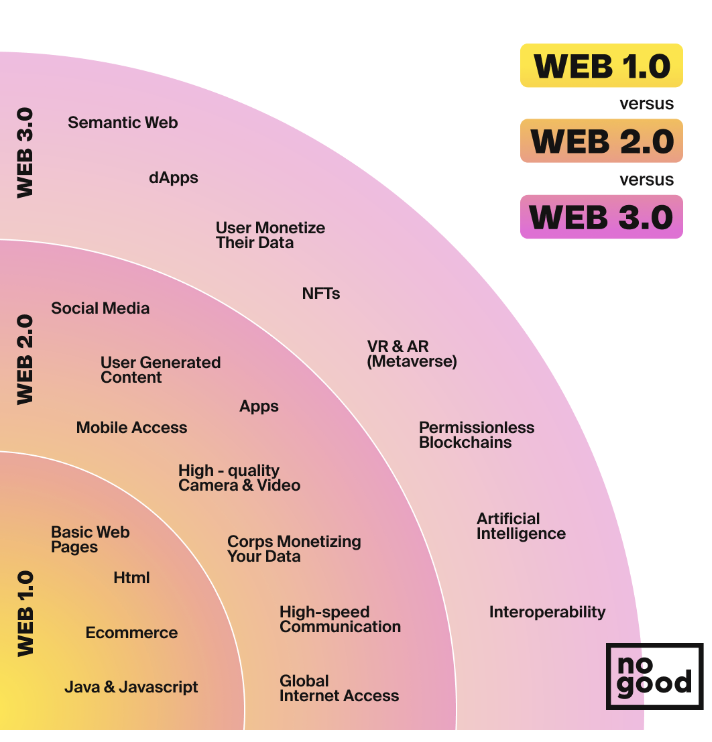Web1 vs. Web2 vs. Web3
THE EVOLUTION OF THE INTERNET AND ITS UNDERLYING TECHNOLOGIES.
Web1 to Web2 to Web3 represents the evolution of the internet and its underlying technologies. Here's a brief explanation of each phase and the transition:
Web1 (Web 1.0):
Web1 refers to the early days of the internet (late 1990s to early 2000s).
It was characterized by static web pages that primarily provided information to users.
Interaction was limited, and content was mostly read-only.
Websites were simple and lacked user-generated content and social interaction.
Search engines like Google emerged during this phase, making it easier to find information on the web.
Web2 (Web 2.0):
Web2 marked a significant shift (mid-2000s onwards).
It introduced dynamic and interactive websites, enabling user-generated content and social networking.
Web2 platforms like Facebook, YouTube, and Twitter encouraged user participation and collaboration.
Rich multimedia, such as videos, images, and interactive applications, became commonplace.
E-commerce and online services saw tremendous growth.
It was often referred to as the "Social Web" due to the emphasis on user engagement and social interactions.
Web3 (Web 3.0):
Web3 is the anticipated next phase (still in development as of my knowledge cutoff date in September 2021).
It aims for a decentralized and more open internet.
Web3 technologies include blockchain, cryptocurrencies, and decentralized applications (DApps).
The focus is on user control and data privacy, with individuals owning and controlling their data.
Smart contracts and decentralized finance (DeFi) are key components.
Web3 envisions a more trustless and secure web, with less reliance on intermediaries.
It aims to disrupt traditional internet models and create a more equitable digital landscape.
The transition from Web1 to Web2 involved the transformation from static, information-focused websites to dynamic, user-centric platforms. Web3, on the other hand, represents a shift towards decentralization, user empowerment, and the use of blockchain technology to create trust and transparency on the internet. The transition from Web2 to Web3 is ongoing, with various projects and initiatives working towards its realization.
Web3 (Web 3.0), a deeper dive:
Web3 represents a paradigm shift in the way the internet operates, aiming to address several limitations of Web2 and offer new possibilities:
Decentralization:
Web3 is built on the idea of decentralization, where data and applications are distributed across a network of nodes (computers) rather than relying on centralized servers. This reduces the power and control of centralized authorities.
Blockchain Technology:
Blockchain is a foundational technology in Web3, providing a secure and transparent ledger for transactions and data storage. It ensures trust and immutability of records.
Cryptocurrencies like Bitcoin and Ethereum play a central role in Web3, facilitating peer-to-peer transactions and smart contracts.
User Ownership and Control:
In Web3, individuals have greater ownership and control over their data and digital identities.
Users can choose to share data selectively and benefit from services without sacrificing their privacy.
Smart Contracts and DApps:
Web3 introduces smart contracts, self-executing contracts with the terms of the agreement directly written into code. They enable automated and trustless transactions.
Decentralized Applications (DApps) are built on blockchain and run on a distributed network, providing various services, from finance (DeFi) to gaming.
Interoperability:
Web3 promotes interoperability between different blockchain networks and DApps, allowing them to work together seamlessly.
This interoperability can lead to a more connected and integrated digital ecosystem.
Data Trust and Security:
Data breaches and centralized control are major concerns in Web2. Web3 aims to enhance data security and trust by eliminating single points of failure.
Tokenization and NFTs:
Non-Fungible Tokens (NFTs) are unique digital assets that represent ownership of digital or physical items. They have gained popularity in Web3 for art, collectibles, and more.
Challenges and Ongoing Development:
Web3 is still in its early stages, facing challenges like scalability, energy consumption, and regulatory issues.
Many projects and communities are actively working on shaping the Web3 landscape.
The transition from Web2 to Web3 involves a gradual shift in internet infrastructure, business models, and user behavior. As Web3 matures, it has the potential to revolutionize various industries, including finance, identity management, supply chain, and more, by offering greater transparency, security, and user empowerment.
Web3 represents a vision for a more decentralized and user-centric internet, where individuals have more agency and control over their online presence and interactions.
Sources:
Web 2 vs. Web 3: What's the Difference and Why It Matters

